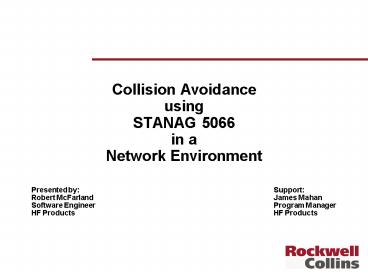Collision Avoidance using STANAG 5066 in a Network Environment - PowerPoint PPT Presentation
1 / 16
Title:
Collision Avoidance using STANAG 5066 in a Network Environment
Description:
Collection of layered protocols for data communications over High ... Supports the automatic adaptation of user data rate to changing radio channel conditions ... – PowerPoint PPT presentation
Number of Views:102
Avg rating:3.0/5.0
Title: Collision Avoidance using STANAG 5066 in a Network Environment
1
Collision AvoidanceusingSTANAG 5066in
aNetwork Environment
Presented byRobert McFarlandSoftware
EngineerHF Products
SupportJames MahanProgram ManagerHF Products
2
STANAG 5066
- NATO Standardization Agreement
- Collection of layered protocols for data
communications over High Frequency (HF) radio - Reliability provided for by a using a Automatic
Repeat Request (ARQ) data link protocol - Supports the automatic adaptation of user data
rate to changing radio channel conditions - Provides an interface for external users
(clients) to exchange data using the subnetwork
3
STANAG 5066
4
STANAG 5066
- Typical point-to-point data communication using a
softlink
5
Network Environment
- STANAG 5066 nodes participate in a subnetwork
- Subnetwork connection
- Common Channel using CAS type 1 protocol for link
establishment - Multiple Channels using CAS type 0 for link
establishment - CAS type 0 uses an external linking protocol such
as MIL-STD 141 (ALE) - External protocol controls channel access
6
Network Environment
- A common occurrence in the subnetwork is that
many nodes want to communicate at the same time
which can lead to collisions - Collisions require retransmissions and delays
which lower channel throughput
7
Collision Avoidance
- Carrier Sense Multiple Access with Collision
Detection (CSMA/CD) is a protocol used in wired
networks where the sender can detect collisions
by comparing what is heard with what was sent - In a wireless network, the sender receives all
that it sent or nothing, in either case,
collisions are not easily detected - CSMA/CA is a wireless network protocol that
attempts to Avoid Collisions
8
Collision Avoidance
- The protocol starts by listening for carrier
(Carrier Sense) - Channel Idle then node transmits
- Channel Busy then the node waits
- Contention interval
- All waiting nodes contend for the channel by
selecting a random delay - After the their delay, a node can transmit if
channel is still idle thus avoiding a collision
9
Collision Avoidance
- Carrier Sense is provided by the Data Carrier
Detect (DCD) input to the STANAG 5066 host - Signaled by the HF Modem with valid data
- Signaled by the COMSEC device with valid data
- DCD is not instantaneous
- Propagation delay
- Modem interleaver delay
- COMSEC delay
10
Collision Avoidance
- Slots Due to the delay in DCD, nodes must be
constrained to begin their transmission at
certain times otherwise a node would never know
how long to listen - Slot Width The interval between start times must
be long enough to insure that all nodes can
detect the transmission before the beginning of
the next slot - Number of Slots A balance between probability of
one and only one node selecting the winning slot
and acceptable delay (eg. 3 nodes,
90probability, 16 slots)
11
Collision Avoidance
- Listen Before Transmit (LBT) Interval
- Starts when carrier is no longer detected
- Reset whenever carrier is detected
- When the LBT interval expires, a contention
interval starts - Used to insure that the softlink data exchange
between two nodes is complete
12
Collision Avoidance
13
Collision Avoidance
- Test Setup
- Subnetwork consisting of 3 nodes
- 1Kbyte messages generated at each node for each
other node every two minutes - Number of Slots 16
- Slot Width 3 seconds
- LBT Interval 30 seconds
- 110B waveform, 3200 bps, short interleaver
14
Collision Avoidance
- Test Procedure
- Test ran multiple times with Collision Avoidance
enabled and with Collision Avoidance disabled - Test duration 1 - 14 hours
- Messages generators were started at each node at
approximately the same time - After each test, undelivered messages were
deleted and the nodes reset
15
Collision Avoidance
- Test Results
- Collision Avoidance disabled On average, 35
messages successfully delivered in 60 minutes - Collision Avoidance enabled On average, 170
messages successfully delivered in 60 minutes
16
Collision Avoidance
- Disclaimers
- This is Collision Avoidance not Collision
Prevention































